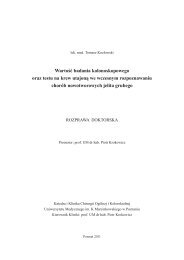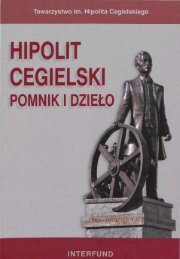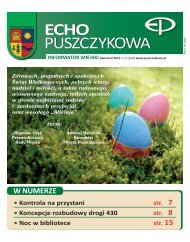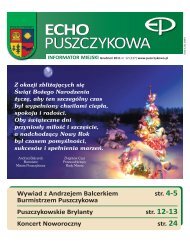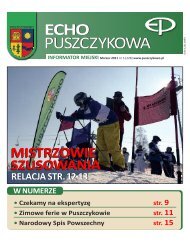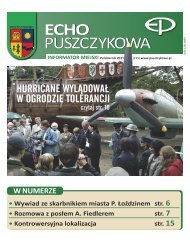MILITARY PHARMACY AND MEDICINE
MILITARY PHARMACY AND MEDICINE
MILITARY PHARMACY AND MEDICINE
You also want an ePaper? Increase the reach of your titles
YUMPU automatically turns print PDFs into web optimized ePapers that Google loves.
© Military Pharmacy and Medicine • 2012 • 4 • 82 – 86anatomists-doctors, Herophilus and Erasistratos,worked there.In the Roman world, autopsies of human remainswere prohibited due to ethnic and religious reasons.Anatomy known from the writings of Galen(a doctor, who lived in the 2 nd century A.D.) isthat of animals: pigs and apes.In the Middle Ages, knowledge of anatomy wasbased on schematic pictures and writings by Hyppocratesand Galen. A papal or royal permissionwas required for performing an autopsy. A humanbeing was considered a microcosmos — reflectionof the surrounding macrocosmos [4].Thanks to artists, painters and sculptors, interestin human physique increased during renaissance.In the history of medicine, the 16th centuryis known as a “century of anatomists.” In 1543,Andreas Vesalius published his work: De humanicorporis fabrica libri septem, where he pointed outtwo hundred of Galen’s errors. This date is consideredthe border between medieval and modernanatomy. Vesalius’ drawings portray the skeletal,cardiovascular systems and musculature, with thecorpse depicted in a vertical position instead oflying down on the examination table [5].At the turn of the 15 th and 16 th century the firstanatomical theaters are created in Padua, Montpellierand Basil. They were particularly numerousin the 17 th century.In this publication, based on anthropologicaldata (acquired from archeological excavationsites), we will try to demonstrate how anatomicalstudies developed in the region of Poland andwhen they were commenced. We will try to comparethese data with written sources. Traces ofpost-mortem examinations found on the skullsand other parts of the skeleton prove that barbersand doctors were interested in how a humanbeing is built.Skulls found during archeological excavationswith openings encompassing the entire or almostentire skull vaults are examples of probable postmortemexaminations. We possess several suchskulls from Poland, but most of them are not preciselydated. It is difficult to unequivocally assesswhether these autopsies were anatomopathologicalor judicial.Review articleNames of the medics appear for the first timein the written sources from 13 th century. Therewere 25 medics and physicians noted during thattime. Wroclaw was the greatest medical centerof the 13 th century. There are several doctorsfrom this city mentioned in the published documents.There were also doctors in Cracow, Legnicaand Poznan. The number of qualified medicsincreased in the 14 th century. Written sourceslist doctors in Cracow, Wroclaw, Glogow, Bytom,Gniezno, Wloclawek as well as in Pomerania.Physicians focused around princely and bishops’courts, as well as Jagiellonian University in the15 th century [6].In the 14 th century, the first post-mortem examinationswere performed in Italy: Padua, Venice,Florence and in France: Montpellier. In renaissance,many artists, including Leonardo daVinci, were interested in studies on human anatomy.His biographers report that he witnessedautopsies in the Santa Maria Novella hospitaland perhaps performed some of them personally.He undertook the trouble to study all stagesof human development, beginning with infancyand ending with senescence. He describedthe skeletal, cardiovascular, nervous systemsand musculature [7].According to the written sources, the first knownpublic autopsy in Poland was performed in 1613in a village called Pruszcz, located near Gdansk,on a deformed newborn baby. In the 16 th century,a gymnasium in Gdansk was the only placewhere regular lectures on anatomy took place. In1580, a separate chair of anatomy and medicinewas formed in Gdansk [8]. The first autopsy wasperformed at the Jagiellonian University in Cracowby Rafal Jozef Czerwiakowski in 18 th century[9]. Thus, written data indicate that post-mortemexaminations were first performed in Poland atthe turn of 17 th and 18 th century.The first skull to be discussed was found inOpole, in a cemetery dated to the 14 th century.Articles by prof. Adam Paluch describe it as atrepanation skull [10, 11]. However, it stands outbetween other trepanation skulls due to orificedimensions and technique of its execution. Thisopening is particularly wide and was performedafter death. The skull was found during excavationsin the Opole Market Square and its features82 http://military.isl-journals.com



